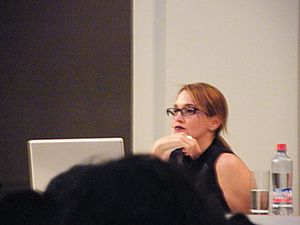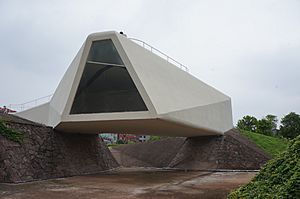Tatiana Bilbao facts for kids
Quick facts for kids
Tatiana Bilbao Spamer
|
|
|---|---|
 |
|
| Born | 1972 (age 52–53) Mexico City, Mexico
|
| Education | Universidad Iberoamericana |
| Awards |
|
Tatiana Bilbao Spamer (born in 1972) is a famous architect from Mexico. She is known for designing buildings that mix modern shapes with nature. Her work often focuses on creating buildings that are good for the environment (this is called sustainable design), designing museums, and building affordable homes for people.
Tatiana Bilbao started her own design studio, Tatiana Bilbao ESTUDIO, in 2004. She has worked on projects in many countries, including China, France, the United States, Mexico, and Guatemala. Some of her well-known projects include the Botanical Garden in Culiacán, Mexico, and an exhibition hall in a park in Jinhua, China. She also designed a special type of affordable home that can be easily copied and built for a low cost. This house was shown at the Chicago Architecture Biennial in 2015.
Tatiana Bilbao has received many awards for her amazing work. These include the Berliner Kunstpreis in 2012, the Global Award for Sustainable Architecture in 2014, and the Marcus Prize in 2019.
Contents
Biography
Tatiana Bilbao was born in Mexico City, Mexico. She grew up in a family of architects. Her grandfather, Tomás Bilbao Hospitalet, was also an architect and a politician. He moved to Mexico from Spain in 1942.
Tatiana studied architecture at the Universidad Iberoamericana. She earned her degree in Architecture and Urbanism in 1996. In 1998, she received a special award for having the best architecture project of the year. Tatiana is very passionate about designing homes that are good for the environment and affordable for everyone. She wrote in her book, "A House is Not Just a House," that "housing is a human right." She believes that houses should be built for people first, not just to be sold.
Early Life and Inspiration
Tatiana Bilbao's interest in architecture was shaped by events in Mexico City. After a big earthquake in 1985, the government needed to build many new homes quickly. Over 2.5 million houses were built in just six years. However, Tatiana did not like how some developers built these homes, as they sometimes ignored the local culture and environment.
Because of this, Tatiana started working with other architects and a government bank called Infonavit. Their goal was to create new city centers and better living areas. She began designing affordable homes, some costing less than 8,000 Mexican pesos, for people with lower incomes. This experience led her to focus on social housing, which means building homes that are affordable and meet the needs of communities.
From 1998 to 1999, Tatiana worked as an advisor for urban projects in Mexico City. In 1999, she helped start a company called LCM, which explored new and interesting building designs.
In 2004, Tatiana Bilbao co-founded MX.DF, a research center that studies how spaces are used and developed in Mexico City. In the same year, she also started her own company, Tatiana Bilbao Estudio. One of her first big projects was an exhibition pavilion in the Jinhua Architecture Park in China. A famous Chinese artist, Ai Weiwei, chose young architects from around the world to design buildings for this large park. Tatiana's exhibition pavilion, finished in 2007, is one of her most famous early works.
Tatiana's studio has worked on many different projects. These include the Botanical Garden in Culiacán, a special open chapel for a Pilgrimage Route, and a center for biotechnology. She has also continued her work on low-cost housing. So far, her program has built 32 homes to help low-income families own their own houses.
Teaching and Exhibitions
Since 2005, Tatiana Bilbao has shared her knowledge by teaching architecture. She became a design professor at the Universidad Iberoamericana, her old university. She has also been a visiting professor at other well-known universities, including Yale School of Architecture, Peter Behrens School of Architecture, and Rice School of Architecture. She taught at Columbia University's Graduate School of Architecture, Planning, and Preservation.
In 2017, Tatiana helped organize an exhibition called "Perspectives: Tatiana Bilbao Estudio" at the Museum of Contemporary Art (MARCO) in Mexico. This exhibition showed her projects from 2004 to 2017. It was also shown at the Amparo Museum in Puebla a year later.
In 2019, the Louisiana Museum of Modern Art in Denmark featured Tatiana Bilbao's work in an exhibition series called "The Architect's Studio." This exhibition showed how Mexican culture and traditions are important in her designs. It also highlighted her dedication to social and sustainable architecture.
Awards and Recognition
Tatiana Bilbao has received many important awards for her innovative designs:
- In 2007, she won the Design Vanguard "Top 10 Emerging Firm" award.
- In 2010, she was named one of the Architectural League Emerging Voices.
- She received the Kunstpries Berlin award in 2012.
- In 2013, she was honored with the CEMEX Building award.
- In 2014, she received the Global Award for Sustainable Architecture Prize. This award is given to architects who show unique ways to build sustainably and help society.
- In 2017, she won the A+Awards Impact Award for her important work in social housing and sustainable design.
- In 2019, she received the Marcus Prize. In the same year, she was also recognized by the Latin Recording Academy with the Leading Ladies of Entertainment award.
Tatiana Bilbao's designs are so important that they are part of the collections at famous museums. These include the Centre d'Art George Pompidou in Paris, France, the Carnegie Museum of Art, and the Art Institute of Chicago.
Key Projects
Here are some of the notable projects Tatiana Bilbao and her studio have worked on:
- Mazatlán Aquarium, Mexico (expected completion 2021)
- Anahuacalli Museum Extension, Mexico City, Mexico (2016)
- Los Terrenos, San Pedro Garza Garcia, Mexico (2016)
- Observatory House, La Blanca, Mexico (2009)
- Exhibition Room in Jinhua Architecture Park, China (2004–2006)
- Pilgrim's Route, Between Ameca and Talpa de Allende, Mexico (2008–2010)
- Bioinnova, Culiacan, Sinaloa, Mexico (2008–2012)
- Monarch Sustainable Neighbourhood Angangueo, Michoacan, Mexico (2010–2013)
- Housing +, San Cristobal, Chiapas and Acuna, Coahuila, Mexico (2013–2015)
- Lyon La Confluence, France (2013–2017)
- Central Park Mazatlan, Mexico (2015–2018)
- Guatemala Tower, Guatemala (2015–2018)
- Hunter's Point Masterplan, San Francisco, California, USA (2016)
- Estoa – UDEM, Monterrey, Mexico (2016–2019)
- Apan Housing: Ocoyoacac Minimum Housing, Hidalgo, Mexico (2017–2018)
Other Works and Research
Tatiana Bilbao also takes part in research and other creative projects:
- She led a research project called "Twelve Archaeologies of Mexico City's Housing at a Crossroads" from 2016 to 2019.
- She designed the layout and look (called museography) for several art exhibitions. These include "The Rights of Dance: Alexander Calder" at Museo Jumex in Mexico City (2015) and "Mexico Expected / Unexpected Exhibition" in Paris, France (2008–2010).
See also
 In Spanish: Tatiana Bilbao para niños
In Spanish: Tatiana Bilbao para niños


